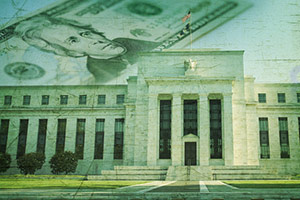The U.S. Federal Reserve's Federal Open Market Committee (FOMC) meeting minutes today (Wednesday) have one thing working in its favor.
It can carry on aimless monetary policy with impunity. The lead dissenters have all but been silenced in 2015.
You see, over the last year, Fed Chairwoman Janet Yellen has had to find a comfortable middle ground between the hawks and the doves within her ranks.
 Does she tease a rate hike through the Fed's periodic statements and risk spooking the markets? Or does she continue on an easy money path that has been artificially propping up the markets for too long?
Does she tease a rate hike through the Fed's periodic statements and risk spooking the markets? Or does she continue on an easy money path that has been artificially propping up the markets for too long?
She's been unsuccessful in answering either question. Instead, she's left investors in the dark and tried to comfort markets with vague assurances that the Fed will keep a discerning eye on the economic picture. She made this clear in last month's press conference following the FOMC meeting.
"It was the finest verbal judo we've seen in a long time," Money Morning Chief Investment Strategist Keith Fitz-Gerald said after the March FOMC meeting. "She said everything about nothing and made it look like Alan Greenspan actually spoke succinctly."
This provides another reason for investors to brush off these Fed meetings. Yellen isn't going to give any clear guidance on the direction of monetary policy.
That's because the Fed doesn't know what it's doing, and it's taking a wait-and-see approach to put off making the tough decisions.
But this year, Yellen can at least "wait and see" without the Fed's clueless approach coming into question from within.
And from a credibility standpoint, that's going to help the Fed. But it's only going to continue to confuse markets...
The Biggest Problem with the FOMC Meeting Minutes Today
The retirements of regional Fed Presidents Richard Fisher and Charles Plosser will silence the case for a clearer timeline on rate hikes.
These two added an important presence to the Fed. Their dissent helped highlight the purposeless goalpost shifting of the FOMC, and its insistence on maintaining a dovish stance in the face of improving economic data.
At one point, the Fed said an unemployment rate of 6.5% would be enough to hike rates. Yellen changed her tune, however, when the U.S. economy came close to reaching that number. In April 2014, it fell to 6.2%. She seemed to openly admit the 6.5% threshold was a misguided benchmark. Instead, she said policy decisions should be fashioned around an all-encompassing view of the economic picture.
Unemployment is now at 5.5%, and we don't know what role this will actually play in the FOMC's rate decision.
Another Fed dissenter, Narayana Kocherlakota, became more important as 2014 wound down and the Fed began to loosen its language on rate hikes.
He hasn't retired yet, but he will not be a voting member in 2015.
[epom key="ddec3ef33420ef7c9964a4695c349764" redirect="" sourceid="" imported="false"]
Deflation has seemingly settled on the U.S. while no one was looking. Kocherlakota feared a more hawkish tone would damage the Fed's credibility to fulfill the other side of its dual mandate: 2% inflation.
His dissent was counter to Plosser and Fisher. But it still raised an important concern.
The CPI just recently posted an anemic 0.2% growth in February. This is after three straight months where the prices fell 0.3% in November, another 0.3% in December, and 0.7% in January.
Monetary easing in Japan and the Eurozone will only further strengthen the dollar, and that will put even more deflationary pressure on the U.S. economy.
The Fed is getting it from both ends. There's enough to support a rate hike, yet there's enough to support further easing.
Yellen doesn't want to take a stand on either side. Instead, she wants to make vague pronouncements as if the Fed has it under control, simply to appease the markets, which have been propped up for the better part of the last decade by Fed intervention.
Doubling down on a Fed-induced, six-year bull market and assuming the good times will never end is naïve. But so is preparing to sell off ahead of a rate hike. Investors shouldn't base their decisions on where they think the Fed is going because the Fed itself doesn't know where it's going.
"You can never totally eliminate risk," Money Morning's Fitz-Gerald said. "I want to place my bets with the world's best CEOs, with the growing brands, with the growing cash flow, with the growing profit margins because that's going to give me the sense that politicians can't or won't."
Some Friendly Advice for Janet Yellen: The bad behavior of Too Big to Fail Banks proves that a criminal culture pervades these institutions. But in response to a question last month, Fed Chair Janet Yellen basically said it was not the Fed's job to try to change this culture. But the truth is, Yellen could change big bank culture with a single stroke of her pen...


